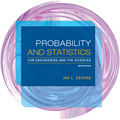
Concept explainers
Construct the ANOVA table and test for significance at 5% level.
Answer to Problem 58SE
The ANOVA table is given below:
| Source |
Degrees of freedom |
Sum of squares |
Mean sum of squares | F-ratio |
|
Vat pressure A | 1 | 6.94 | 6.94 | 11.57 |
|
Cooking time B | 3 | 5.61 | 1.87 | 3.12 |
|
Concentration C | 2 | 12.33 | 6.165 | 10.28 |
| Interaction AB | 3 | 4.05 | 1.35 | 2.25 |
| Interaction BC | 6 | 15.80 | 2.63 | 4.38 |
| Interaction AC | 2 | 7.32 | 3.66 | 6.10 |
| Interaction ABC | 6 | 4.37 | 0.728 | 1.21 |
| Error | 24 | 14.40 | 0.6 | |
| Total | 47 | 70.82 |
There is sufficient of evidence to conclude that there is an effect of vat pressure on the strength of the paper at 5% level of significance.
There is sufficient of evidence to conclude that there is an effect of cooking times on the strength of the paper at 5% level of significance.
There is sufficient of evidence to conclude that there is an effect of concentrations on the strength of the paper at 5% level of significance.
There is no sufficient of evidence to conclude that there is an interaction effect of vat pressure and cooking times on the strength of the paper at 5% level of significance.
There is sufficient of evidence to conclude that there is an interaction effect of cooking times and concentrations on the strength of the paper at 5% level of significance.
There is sufficient of evidence to conclude that there is an interaction effect of vat pressure and concentrations on the strength of the paper at 5% level of significance.
There is no sufficient of evidence to conclude that there is an interaction effect of vat pressure and concentrations on the strength of the paper at 5% level of significance.
Explanation of Solution
Given info:
An experiment was carried out to test the vat pressure A, cooking time of pulp B and hardwood concentration C on the strength of the paper.
The sum of squares of factor A is 6.94, due to factor B is 5.61, due to factor C is 12.33, due to interaction AB is 4.05, due to interaction BC is 15.80, due to interaction AC is 7.32, sum of squares due to error and total sum of squares is 14.40 and 70.82.
Two observations were made at each combination of factor levels.
Calculation:
The sum of squares due to the interaction of factor A, B and C is calculated as follows:
The general ANOVA table is given below:
| Source | Degrees of freedom | Sum of squares | Mean sum of squares | F-ratio |
| Factor A | ||||
| Factor B | ||||
| Factor C | ||||
| Interaction AB | ||||
| Error | ||||
| Total |
The ANOVA for the given data is shown below:
| Source | Degrees of freedom |
Sum of squares | Mean sum of squares | F-ratio |
|
Vat pressure A | 6.94 | 11.57 | ||
|
Cooking time B | 5.61 | 3.12 | ||
|
Concentration C | 12.33 | 10.28 | ||
| Interaction AB | 4.05 | 2.25 | ||
| Interaction BC | 15.80 | 4.38 | ||
| Interaction AC | 7.32 | 6.10 | ||
| Interaction ABC | 4.37 | 1.21 | ||
| Error | 14.40 | |||
| Total | 70.82 |
Where, the F statistic for each factor is obtained by dividing the mean sum of squares with the mean error sum of squares (MSE).
Testing the Hypothesis for the main effect A:
Null hypothesis:
That is, there is no significant difference in the strength of the paper due to the two levels of vat pressure.
Alternative hypothesis:
That is, there is significant difference in the strength of the paper due to the two levels of vat pressure.
Testing the Hypothesis for the main effect B:
Null hypothesis:
That is, there is no significant difference in the strength of the paper due to the four levels of cooking times.
Alternative hypothesis:
That is, there is significant difference in the strength of the paper due to the four levels of cooking times.
Testing the Hypothesis for the main effect C:
Null hypothesis:
That is, there is no significant difference in the strength of the paper due to the three levels of concentrations.
Alternative hypothesis:
That is, there is a significant difference in the strength of the paper due to the three levels of concentrations.
Testing the Hypothesis for the interaction effect of AB:
Null hypothesis:
That is, there is no significant difference in the strength due to the interaction between vat pressure and cooking times.
Alternative hypothesis:
That is, there is significant difference in the strength due to the interaction between vat pressure and cooking times.
Testing the Hypothesis for the interaction effect BC:
Null hypothesis:
That is, there is no significant difference in the strength due to the interaction between cooking times and concentrations.
Alternative hypothesis:
That is, there is significant difference in the strength due to the interaction between cooking times and concentrations.
Testing the Hypothesis for the interaction effect AC:
Null hypothesis:
That is, there is no significant difference in the strength of the paper due to the interaction between vat pressure and concentrations.
Alternative hypothesis:
That is, there is a significant difference in the strength of the paper due to the interaction between vat pressure and concentrations.
Testing the Hypothesis for the interaction effect ABC:
Null hypothesis:
That is, there is no significant difference in the strength of the paper due to the interaction between vat pressure, cooking times and concentrations.
Alternative hypothesis:
That is, there is a significant difference in the strength of the paper due to the interaction between vat pressure, cooking times and concentrations.
P-value for the main effect of A:
Software procedure:
Step-by-step procedure to find the P-value is given below:
- Click on Graph, select View Probability and click OK.
- Select F, enter 1 in numerator df and 24 in denominator df.
- Under Shaded Area Tab select X value under Define Shaded Area By and select right tail.
- Choose X value as 11.57.
- Click OK.
Output obtained from MINITAB is given below:
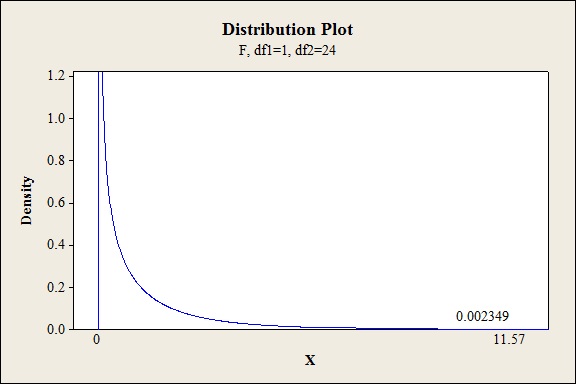
P-value for the main effect of B:
Software procedure:
Step-by-step procedure to find the P-value is given below:
- Click on Graph, select View Probability and click OK.
- Select F, enter 3 in numerator df and 24 in denominator df.
- Under Shaded Area Tab select X value under Define Shaded Area By and select right tail.
- Choose X value as 3.12.
- Click OK.
Output obtained from MINITAB is given below:
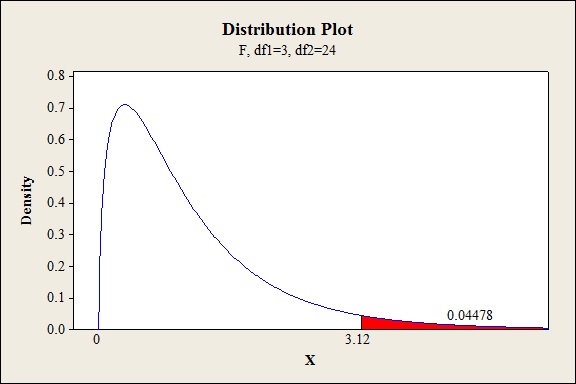
P-value for the main effect of C:
Software procedure:
Step-by-step procedure to find the P-value is given below:
- Click on Graph, select View Probability and click OK.
- Select F, enter 2 in numerator df and 24 in denominator df.
- Under Shaded Area Tab select X value under Define Shaded Area By and select right tail.
- Choose X value as 10.28.
- Click OK.
Output obtained from MINITAB is given below:
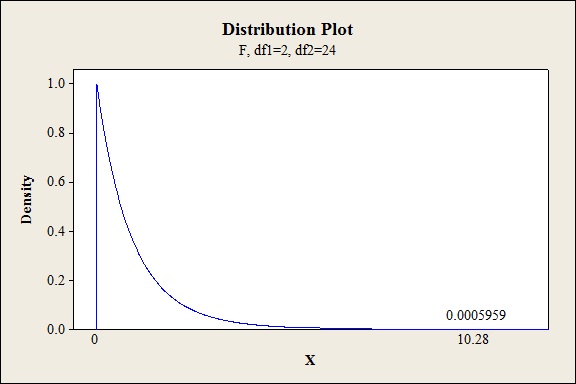
P-value for the interaction effect of AB:
Software procedure:
Step-by-step procedure to find the P-value is given below:
- Click on Graph, select View Probability and click OK.
- Select F, enter 3 in numerator df and 24 in denominator df.
- Under Shaded Area Tab select X value under Define Shaded Area By and select right tail.
- Choose X value as 2.25.
- Click OK.
Output obtained from MINITAB is given below:
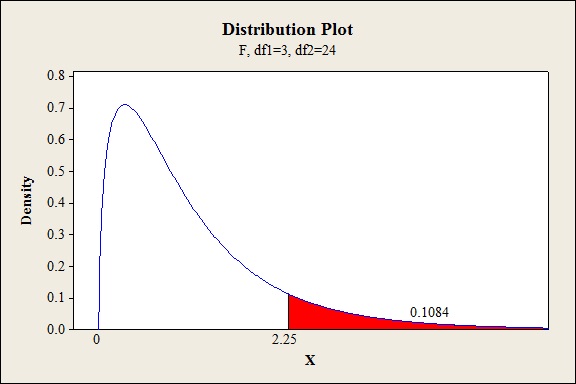
P-value for the interaction effect of BC:
Software procedure:
Step-by-step procedure to find the P-value is given below:
- Click on Graph, select View Probability and click OK.
- Select F, enter 6 in numerator df and 24 in denominator df.
- Under Shaded Area Tab select X value under Define Shaded Area By and select right tail.
- Choose X value as 4.39.
- Click OK.
Output obtained from MINITAB is given below:
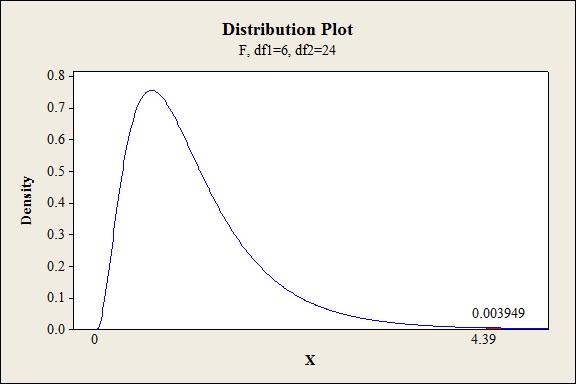
P-value for the interaction effect of AC:
Software procedure:
Step-by-step procedure to find the P-value is given below:
- Click on Graph, select View Probability and click OK.
- Select F, enter 2 in numerator df and 24 in denominator df.
- Under Shaded Area Tab select X value under Define Shaded Area By and select right tail.
- Choose X value as 6.10.
- Click OK.
Output obtained from MINITAB is given below:
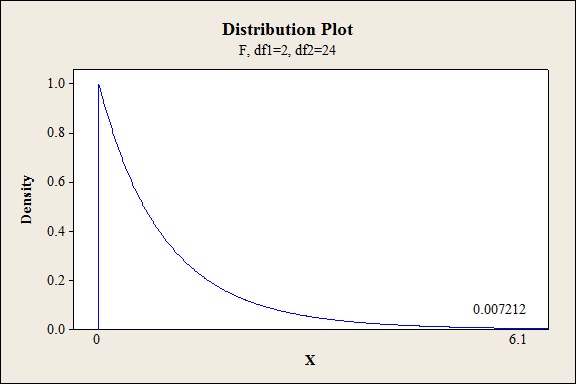
P-value for the interaction effect of ABC:
Software procedure:
Step-by-step procedure to find the P-value is given below:
- Click on Graph, select View Probability and click OK.
- Select F, enter 6 in numerator df and 24 in denominator df.
- Under Shaded Area Tab select X value under Define Shaded Area By and select right tail.
- Choose X value as 1.21.
- Click OK.
Output obtained from MINITAB is given below:
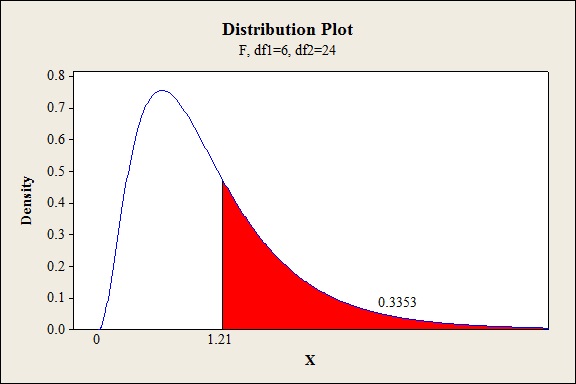
Conclusion:
For the main effect of A:
The P- value for the factor A (vat pressure) is 0.002 and the level of significance is 0.05.
Here, the P- value is lesser than the level of significance.
That is,
Thus, the null hypothesis is rejected,
Hence, there is sufficient of evidence to conclude that there is an effect of vat pressure on the strength of the paper at 5% level of significance.
For main effect of B:
The P- value for the factor B (cooking times) is 0.044 and the level of significance is 0.05.
Here, the P- value is lesser than the level of significance.
That is,
Thus, the null hypothesis is rejected.
Hence, there is sufficient of evidence to conclude that there is an effect of cooking times on the strength of the paper at 5% level of significance.
For main effect of C:
The P- value for the factor C (concentrations) is 0.000 and the level of significance is 0.05.
Here, the P- value is lesser than the level of significance.
That is,
Thus, the null hypothesis is rejected.
Hence, there is sufficient of evidence to conclude that there is an effect of concentrations on the strength of the paper at 5% level of significance.
For the interaction effect of AB:
The P- value for the interaction effect AB (vat pressure and cooking times) is 0.1084 and the level of significance is 0.05.
Here, the P- value is greater than the level of significance.
That is,
Thus, the null hypothesis is not rejected,
Hence, there is no sufficient of evidence to conclude that there is an interaction effect of vat pressure and cooking times on the strength of the paper at 5% level of significance.
For the interaction effect of BC
The P- value for the interaction effect BC (cooking times and concentrations) is 0.004 and the level of significance is 0.05.
Here, the P- value is lesser than the level of significance.
That is,
Thus, the null hypothesis is rejected,
Hence, there is sufficient of evidence to conclude that there is an interaction effect of cooking times and concentrations on the strength of the paper at 5% level of significance.
For the interaction effect of AC:
The P- value for the interaction effect AC (vat pressure and concentrations) is 0.0072 and the level of significance is 0.05.
Here, the P- value is lesser than the level of significance.
That is,
Thus, the null hypothesis is rejected,
Hence, there is sufficient of evidence to conclude that there is an interaction effect of vat pressure and concentrations on the strength of the paper at 5% level of significance.
For the interaction effect of ABC:
The P- value for the interaction effect ABC (vat pressure, cooking times and concentrations) is 0.3353 and the level of significance is 0.05.
Here, the P- value is greater than the level of significance.
That is,
Thus, the null hypothesis is not rejected,
Hence, there is no sufficient of evidence to conclude that there is an interaction effect of vat pressure, cooking times and concentrations on the strength of the paper at 5% level of significance.
The main effect A, B and C appears to be significant at 5% level. The interactions BC and AC are significant at 5% level of significance and the interactions AB and ABC are not significant at 5% level of significance.
Want to see more full solutions like this?
Chapter 11 Solutions
EBK PROBABILITY AND STATISTICS FOR ENGI
- Problem 4. Margrabe formula and the Greeks (20 pts) In the homework, we determined the Margrabe formula for the price of an option allowing you to swap an x-stock for a y-stock at time T. For stocks with initial values xo, yo, common volatility σ and correlation p, the formula was given by Fo=yo (d+)-x0Þ(d_), where In (±² Ꭲ d+ õ√T and σ = σ√√√2(1 - p). дго (a) We want to determine a "Greek" for ỡ on the option: find a formula for θα (b) Is дго θα positive or negative? (c) We consider a situation in which the correlation p between the two stocks increases: what can you say about the price Fo? (d) Assume that yo< xo and p = 1. What is the price of the option?arrow_forwardWe consider a 4-dimensional stock price model given (under P) by dẴ₁ = µ· Xt dt + йt · ΣdŴt where (W) is an n-dimensional Brownian motion, π = (0.02, 0.01, -0.02, 0.05), 0.2 0 0 0 0.3 0.4 0 0 Σ= -0.1 -4a За 0 0.2 0.4 -0.1 0.2) and a E R. We assume that ☑0 = (1, 1, 1, 1) and that the interest rate on the market is r = 0.02. (a) Give a condition on a that would make stock #3 be the one with largest volatility. (b) Find the diversification coefficient for this portfolio as a function of a. (c) Determine the maximum diversification coefficient d that you could reach by varying the value of a? 2arrow_forwardQuestion 1. Your manager asks you to explain why the Black-Scholes model may be inappro- priate for pricing options in practice. Give one reason that would substantiate this claim? Question 2. We consider stock #1 and stock #2 in the model of Problem 2. Your manager asks you to pick only one of them to invest in based on the model provided. Which one do you choose and why ? Question 3. Let (St) to be an asset modeled by the Black-Scholes SDE. Let Ft be the price at time t of a European put with maturity T and strike price K. Then, the discounted option price process (ert Ft) t20 is a martingale. True or False? (Explain your answer.) Question 4. You are considering pricing an American put option using a Black-Scholes model for the underlying stock. An explicit formula for the price doesn't exist. In just a few words (no more than 2 sentences), explain how you would proceed to price it. Question 5. We model a short rate with a Ho-Lee model drt = ln(1+t) dt +2dWt. Then the interest rate…arrow_forward
- In this problem, we consider a Brownian motion (W+) t≥0. We consider a stock model (St)t>0 given (under the measure P) by d.St 0.03 St dt + 0.2 St dwt, with So 2. We assume that the interest rate is r = 0.06. The purpose of this problem is to price an option on this stock (which we name cubic put). This option is European-type, with maturity 3 months (i.e. T = 0.25 years), and payoff given by F = (8-5)+ (a) Write the Stochastic Differential Equation satisfied by (St) under the risk-neutral measure Q. (You don't need to prove it, simply give the answer.) (b) Give the price of a regular European put on (St) with maturity 3 months and strike K = 2. (c) Let X = S. Find the Stochastic Differential Equation satisfied by the process (Xt) under the measure Q. (d) Find an explicit expression for X₁ = S3 under measure Q. (e) Using the results above, find the price of the cubic put option mentioned above. (f) Is the price in (e) the same as in question (b)? (Explain why.)arrow_forwardThe managing director of a consulting group has the accompanying monthly data on total overhead costs and professional labor hours to bill to clients. Complete parts a through c. Question content area bottom Part 1 a. Develop a simple linear regression model between billable hours and overhead costs. Overhead Costsequals=212495.2212495.2plus+left parenthesis 42.4857 right parenthesis42.485742.4857times×Billable Hours (Round the constant to one decimal place as needed. Round the coefficient to four decimal places as needed. Do not include the $ symbol in your answers.) Part 2 b. Interpret the coefficients of your regression model. Specifically, what does the fixed component of the model mean to the consulting firm? Interpret the fixed term, b 0b0, if appropriate. Choose the correct answer below. A. The value of b 0b0 is the predicted billable hours for an overhead cost of 0 dollars. B. It is not appropriate to interpret b 0b0, because its value…arrow_forwardUsing the accompanying Home Market Value data and associated regression line, Market ValueMarket Valueequals=$28,416+$37.066×Square Feet, compute the errors associated with each observation using the formula e Subscript ieiequals=Upper Y Subscript iYiminus−ModifyingAbove Upper Y with caret Subscript iYi and construct a frequency distribution and histogram. LOADING... Click the icon to view the Home Market Value data. Question content area bottom Part 1 Construct a frequency distribution of the errors, e Subscript iei. (Type whole numbers.) Error Frequency minus−15 comma 00015,000less than< e Subscript iei less than or equals≤minus−10 comma 00010,000 0 minus−10 comma 00010,000less than< e Subscript iei less than or equals≤minus−50005000 5 minus−50005000less than< e Subscript iei less than or equals≤0 21 0less than< e Subscript iei less than or equals≤50005000 9…arrow_forward
- The managing director of a consulting group has the accompanying monthly data on total overhead costs and professional labor hours to bill to clients. Complete parts a through c Overhead Costs Billable Hours345000 3000385000 4000410000 5000462000 6000530000 7000545000 8000arrow_forwardUsing the accompanying Home Market Value data and associated regression line, Market ValueMarket Valueequals=$28,416plus+$37.066×Square Feet, compute the errors associated with each observation using the formula e Subscript ieiequals=Upper Y Subscript iYiminus−ModifyingAbove Upper Y with caret Subscript iYi and construct a frequency distribution and histogram. Square Feet Market Value1813 911001916 1043001842 934001814 909001836 1020002030 1085001731 877001852 960001793 893001665 884001852 1009001619 967001690 876002370 1139002373 1131001666 875002122 1161001619 946001729 863001667 871001522 833001484 798001589 814001600 871001484 825001483 787001522 877001703 942001485 820001468 881001519 882001518 885001483 765001522 844001668 909001587 810001782 912001483 812001519 1007001522 872001684 966001581 86200arrow_forwarda. Find the value of A.b. Find pX(x) and py(y).c. Find pX|y(x|y) and py|X(y|x)d. Are x and y independent? Why or why not?arrow_forward
- The PDF of an amplitude X of a Gaussian signal x(t) is given by:arrow_forwardThe PDF of a random variable X is given by the equation in the picture.arrow_forwardFor a binary asymmetric channel with Py|X(0|1) = 0.1 and Py|X(1|0) = 0.2; PX(0) = 0.4 isthe probability of a bit of “0” being transmitted. X is the transmitted digit, and Y is the received digit.a. Find the values of Py(0) and Py(1).b. What is the probability that only 0s will be received for a sequence of 10 digits transmitted?c. What is the probability that 8 1s and 2 0s will be received for the same sequence of 10 digits?d. What is the probability that at least 5 0s will be received for the same sequence of 10 digits?arrow_forward
 College Algebra (MindTap Course List)AlgebraISBN:9781305652231Author:R. David Gustafson, Jeff HughesPublisher:Cengage Learning
College Algebra (MindTap Course List)AlgebraISBN:9781305652231Author:R. David Gustafson, Jeff HughesPublisher:Cengage Learning Algebra: Structure And Method, Book 1AlgebraISBN:9780395977224Author:Richard G. Brown, Mary P. Dolciani, Robert H. Sorgenfrey, William L. ColePublisher:McDougal Littell
Algebra: Structure And Method, Book 1AlgebraISBN:9780395977224Author:Richard G. Brown, Mary P. Dolciani, Robert H. Sorgenfrey, William L. ColePublisher:McDougal Littell Glencoe Algebra 1, Student Edition, 9780079039897...AlgebraISBN:9780079039897Author:CarterPublisher:McGraw Hill
Glencoe Algebra 1, Student Edition, 9780079039897...AlgebraISBN:9780079039897Author:CarterPublisher:McGraw Hill Holt Mcdougal Larson Pre-algebra: Student Edition...AlgebraISBN:9780547587776Author:HOLT MCDOUGALPublisher:HOLT MCDOUGAL
Holt Mcdougal Larson Pre-algebra: Student Edition...AlgebraISBN:9780547587776Author:HOLT MCDOUGALPublisher:HOLT MCDOUGAL Linear Algebra: A Modern IntroductionAlgebraISBN:9781285463247Author:David PoolePublisher:Cengage Learning
Linear Algebra: A Modern IntroductionAlgebraISBN:9781285463247Author:David PoolePublisher:Cengage Learning College AlgebraAlgebraISBN:9781305115545Author:James Stewart, Lothar Redlin, Saleem WatsonPublisher:Cengage Learning
College AlgebraAlgebraISBN:9781305115545Author:James Stewart, Lothar Redlin, Saleem WatsonPublisher:Cengage Learning





